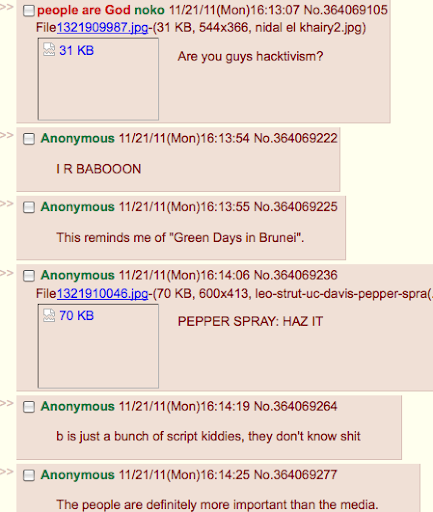
Monday’s discussion, led by Dan Schultz, was centered on evolution of hacktivism, Anonymous, and the pursuit of the lulz. Molly Sauter also dropped by to contribute.
Lulz, while not necessarily as intellectualized, is a modern incarnation of satire as political critique. In times and spaces where open political dissidence is suppressed, jokes and satire are some of the few available outlets for expressing discontent. As a contemporary example, Sasha related a story from 2005 in Tunisia, where critics of Ben Ali posted images of the ruler with a photoshopped clown nose in public spaces. While the stunt may seem “lulzy” to those of us who have grown up in cozy Western liberal democracies, in the context of authoritarian rule, the act comprised an intense, high-risk form of protest.
More on the lulz:
Based on this article by Gabriella Coleman, we discussed the roots of Anonymous and its transition from impish online mockery to real-world action.
Project Chanology was the name of 4chan users’ seminal raid against Scientology. The debacle occurred after anonymous hacktivists leaked a classified video of Tom Cruise waxing maniacal about the Church of Scientology – an institution which is, evidently, very protective of its intellectual property. The Church’s subsequent attempts to take the video off the Internet chafed Anon and its core value of freedom of information. Here, Anonymous’ beef with the Church transcended the lulz, morphing into a more generalized objection to Scientology. 4channers began “black faxing” the Church’s headquarters to waste their ink. Hundreds of people showed up to offline protests wearing Guy Fawkes masks. And so on.
Lulz can also be a way of spreading serious messages, for example, the Pepper Spray Cop meme.
The difference between flash mobs and Anonymous, however, is that the latter is rooted in a deeper political culture and has a more entrenched collective identity.
Next, we talked about the Critical Art Ensemble:
In the 1990s, a group of artists, activists, theorists, coders and makers converged to form a collective identity as one author. By producing a series of texts and interventions, they contributed to the theoretical discussion on media activism. For example, The Flesh Machine was written in opposition to increasing corporate control over the human genome and the new wave of eugenics. When Electronic Disturbance was written in 1994, the work was widely read and caused many people to rethink their conception of protest politics.
Electronic Disturbance Theater was created in 1997. Governed by the belief that in the digital age, the power resides in virtual networks, not in the streets, EDT promoted the pratice of e-civil disobedience. One of their first actions was FloodNet, a program designed to continually reload URLs until servers were brought down. In an attempt to support the Zapatista rebels in Chiapas, EDT simultaneously targeted the sites of the Mexican president and the White House. Whether or not the actions were actually successful in bringing down the websites was less important than generating a media storm.
There are several main critiques of EDT’s brand of electronic civil disobedience. Whereas traditional hacktivists were primarily concerned with the efficacy of the tools themselves, EDT’s actions were geared toward attracting media attention. Old skoolers fear that if the tools are not “tight,” you may be putting people’s lives at risk, and therefore, e-disturbance should only be carried out by highly skilled hackers. In addition, some original hacktivists feel that DDoS attacks are counterproductive to promoting the freedom of information online.
These debates echo the age-old question of political participation: should change be driven by a small group of “elite” representatives, or should we strive towards total inclusion of the masses? Moreover, under what conditions is it valid for people to engage in limited DDoS attacks for political reasons? (I don’t think we arrived at any conclusion.)
To lighten things up, we headed over to 4chan’s /b/ board. Here are some screenshots:


(Apologies for lack of pic-age.)

